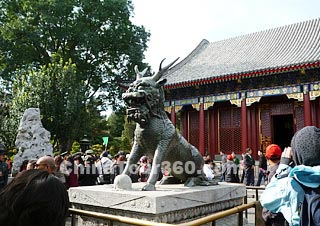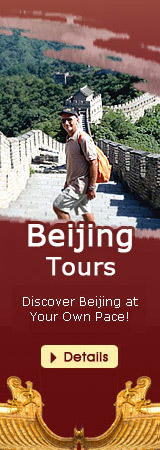 |
| Hall of Benevolence and Longevity |
The Court Area is located on the flat area between the East Palace Gate and northeast shore of Kunming Lake. It is the hub of the land and water transportation and the best position to appreciate the scenery of lakes and hills along the lake in the Summer Palace.
Centering on the Hall of Benevolence and Longevity (Renshou Dian), the Court Area was the place for the emperor to deal with the state affairs, regarded as the second Forbidden City in Beijing. It mainly includes the East Palace Gate, the Gate of Benevolence and Longevity, the Stone of the God of Longevity, the Hall of benevolence and Longevity and the Longevity Well. Although it covers just a small area in the Summer Palace, it is no less important than any other scenic spot in this garden.
![]() East Palace Gate
East Palace Gate
The East Palace Gate, the main gate of the Summer Palace, is a kind of veranda-style building with three exposed doorways and two hidden ones. The central doorway was only for the emperor, with three words ‘Yi He Yuan’ (Summer Palace) written by Emperor Guangxu of the Qing Dynasty (1644 - 1911) at the top. On the Danbi stone in front of the gate there was a carving of ‘two dragons playing with a pearl’, which was formerly a relic of the Old Summer Palace. The symbolic building in the square in front of the gate is a memorial archway written with two Chinese characters “Han Xu” which imply water. On its back are another characters ‘Yan Xiu’ which imply mountain.
![]() Gate of Benevolence and Longevity (Renshou Men)
Gate of Benevolence and Longevity (Renshou Men)
Between the East Palace Gate and the Hall of Benevolence and Longevity is the Gate of Benevolence and Longevity. The gate was built through blending the designs of the decorated gateway and the ceremonial gate of the government office in ancient China, appearing solemn and elegant. On both sides of the gate, there is a blue stone - one is like a monkey, and the other is like a pig. The two stones are together known as ‘Pig Monkey Stones’, with the implication that the Monkey King and the Piggy, two imaginary figures in Chinese mythology, are guarding the royal gate together.
![]() Stone of the God of Longevity (Shouxing Shi)
Stone of the God of Longevity (Shouxing Shi)
Speaking of stone, the Stone of the God of Longevity (Shouxing Shi), caved with a huge Taihu stone, is the most attractive in the Summer Palace. It is located at the central area inside the Gate of Benevolence and Longevity. It is 3.9 meters (12.8 feet) high and 2.1 meters (2.3 yards) wide. It got its name, since it is shaped like a person of longevity who is making a bow with clasped hands.
![]() Hall of Benevolence and Longevity (Renshou Dian)
Hall of Benevolence and Longevity (Renshou Dian)
Formerly known as the hall of Diligent Government (Qinzheng Dian), the Hall of Benevolence and Longevity was initially built in the 15th year of Emperor Qianlong’s reign in 1750. It was burnt down by the Anglo-French Allied Force in 1860. Later, it was restored, and renamed Hall of Benevolence and Longevity from the Analects of Confucius in the 12th year of Emperor Guangxu’s reign in 1886. It was the place for Empress Dowager Cixi and Emperor Guanxu to meet their ministers and to receive foreign diplomatic envoys when they lived in the Summer Palace. Thus, it was the heart of the Court Area, and the Hundred Days of Reform was schemed in the hall.
In front of the Hall of Benevolence and Longevity are two bronze vats laid to either side. Just like those in the Forbidden City, they were used to store water and acted as fireproofing appliances.
![]() Longevity Well (Yannian Jing)
Longevity Well (Yannian Jing)
To the north of the Hall of Benevolence and Longevity, there is a well-named Longevity Well. It’s said that Empress Dowager Cixi got sunstroke when visiting the garden one day. Thanks to the water of this well, she cooled down. Therefore, she gave the name 'Longevity Well'. Another story has it that Empress Dowager Cixi especially came here to drink the water of the well before leaving Beijing when the Eight-Power Allied Forces invaded Beijing in 1900.
![]() Go to the Next Scenic Area: Imperial Living Area
Go to the Next Scenic Area: Imperial Living Area








